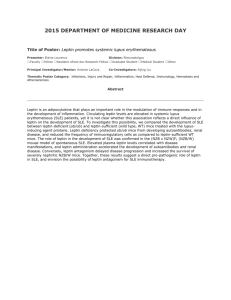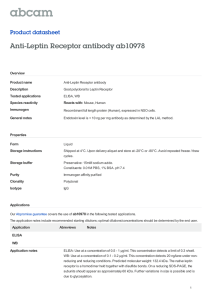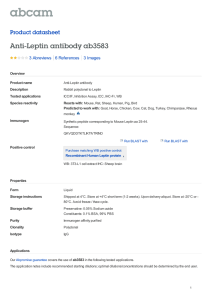Speaker:Chung-Han Wang
advertisement
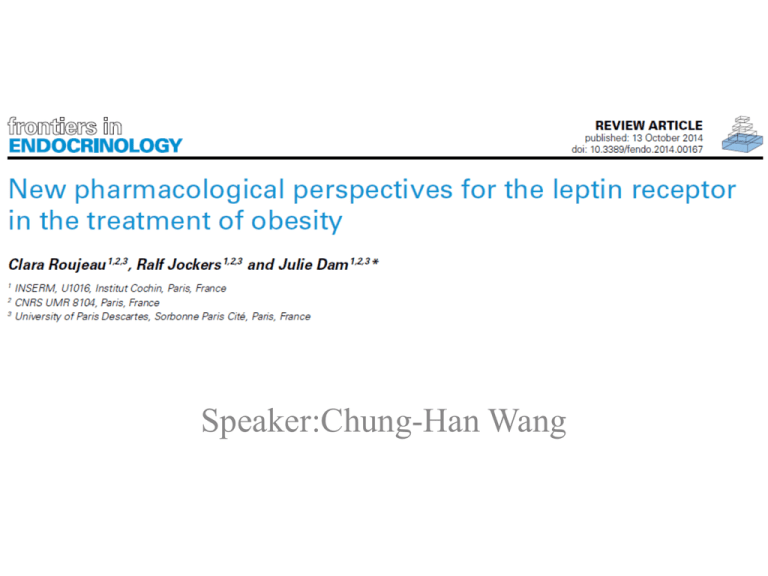
Speaker:Chung-Han Wang introduction • Obesity being one of the major issues of public health nowadays, with more than 500 million obese adults worldwide in 2011 . • Obesity is a chronic disease, which originates from a myriad of causes leading to a steady imbalance between energy intake and energy expenditure -fat mass has been correlated to higher risk of developing severe diseases such as type 2 diabetes, cardiovascular disease, and cancers. • A pharmacological drug against obesity must result- 1.food intake 2.increase in energy expenditure • The discovery of leptin in 1994 raised the possibility of new therapeutic strategies to combat obesity epidemic. • Recombinant leptin to obese rodents and humans with congenital leptin deficiency significantly decreases body weight and food intake. • leptin therapy for patients with very low leptin or leptin deficiency has proven to be relevant for diseases such as lipoatrophy, anorexia nervosa, hypothalamic amenorrhea, and some neuroendocrine disturbances. • Recombinant leptin monotherapy is totally inefficient in decreasing body weight of diet-induced obese (DIO) mice as well as obese humans who are not leptindeficient but rather hyperleptinemic, associated with a loss of responsiveness to leptin. • These observations led to the concept of so-called “leptin resistance.” Few words on leptin and the leptin receptor • Leptin, a peptidic hormone mainly secreted by white adipose tissue, is essential in the control of energy homeostasis-food intake and energy expenditure-binding of leptin to its receptor OBR, a type I cytokine receptor. • Several isoforms of OBR have been described as a result of alternative mRNA splicing leading to several short isoforms (OBRa, OBRc, OBRd, and OBRf), one long isoform OBRb with a long cytosolic C-terminus tail and one soluble isoform OBRe. • OBRb expression is more restricted with high levels in hypothalamic nuclei such as the arcuate nucleus (ARC)-in the development of leptin resistance. • Accordingly, exposure of rodents to a high-fat diet rapidly decreases the phosphorylation of STAT3 in the ARC or the ventral tegmental area (VTA), while leptin-sensitivity is simultaneously maintained in some other hypothalamic nuclei. OBRb is able to trigger various signal transduction pathways • OBRb is the main isoform responsible for the effect of leptin on body weight control. • Activation of the Janus tyrosine kinase 2 (JAK2)/signal transducer and activator of transcription 3 (STAT3) pathway leads to an increase of anorexigenic signals and a decrease of orexigenic signals. • Leptin is also able to activate the insulin receptor substrate (IRS)/phosphatidylinositide 3-kinase (PI3K) pathway, essential for the regulation of glucose homeostasis. • leptin inhibits in the brain the energy sensor, adenosine monophosphate-activated protein kinase (AMPK), to decrease eating. • The activation of extracellular signal-regulated kinase (ERK) is another pathway mediating the anorectic action of leptin in the hypothalamus. • Leptin binding to its receptor OBR is the first event triggering conformational change and eventual oligomerization of OBR, both necessary for receptor activation and subsequent signal transduction OBR structure CRH1: cytokine receptor homologous domain Ig: Immunoglobulin FNIII: two fibronectin type 3 TM: transmembrane region • CRH2 and Ig leptin binding and receptor activation. N-terminal region Leptin and OBR binding structure • Binding site I: poorly defined • Binding site II: high affinity interaction leptin and the OBR CRH2 domain • Binding site III: 1.conformational changes 2.activation of OBR Ig domain • leptin mutations at site I (L39A/D40A/F41A) and III (S120A/T121A) become antagonists. • leptin gene -ob/ob mice leptin receptor gene-db/db mice, fa/fa rats • A409E and R612H on human OBR lead to severe obesity in patients possibly by impairing binding site III and binding site II. • macronutrients fat and sugar are detrimental to leptin sensitivity-leptin resistance is not yet completely understood. Potential therapeutic targets for the prevention or reversal of leptin resistance 1. 3. 4. 2. 5. 4. 1.increase of leptin signaling with new OBR agonists 2. decrease of the inhibitory function of OBR negative regulators(SOCS3, PTP1B) 3. Increase of leptin transport across the blood–brain barrier or median eminence 4. increase of OBR cell surface expression by enhancing OBR anterograde traffic and recycling or by decreasing OBR constitutive internalization and lysosomal degradation (endospanin 1-dependent pathways) 5. decrease of ER stress
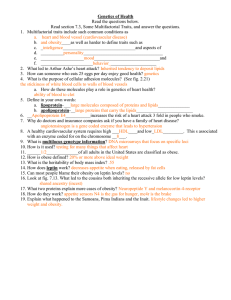
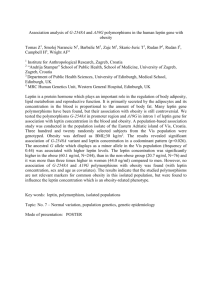
![Anti-Leptin Receptor antibody [RM0085-9C29] ab86060](http://s2.studylib.net/store/data/013356560_1-aa9ce91a5e72d6ada07df09c27508627-300x300.png)
